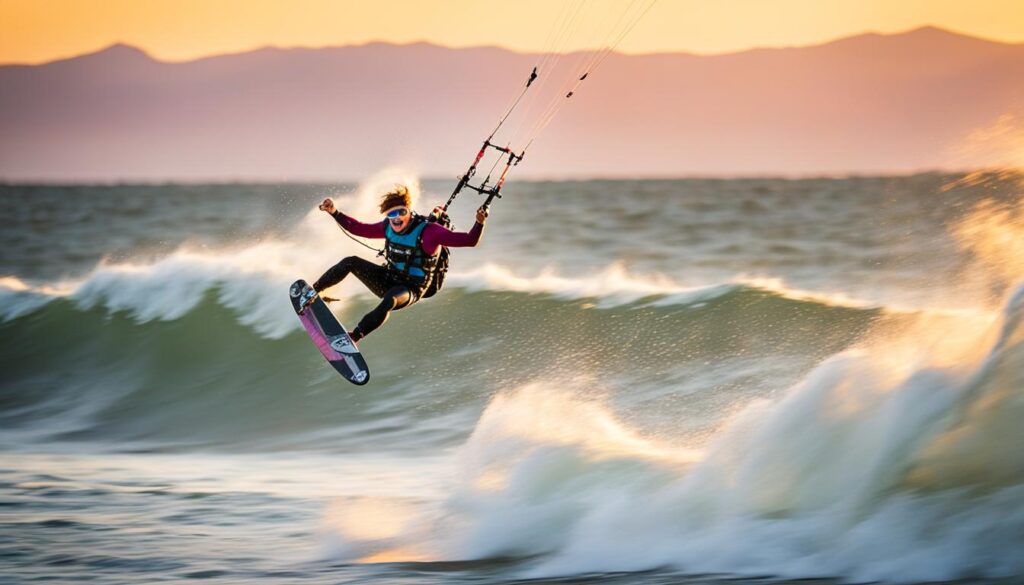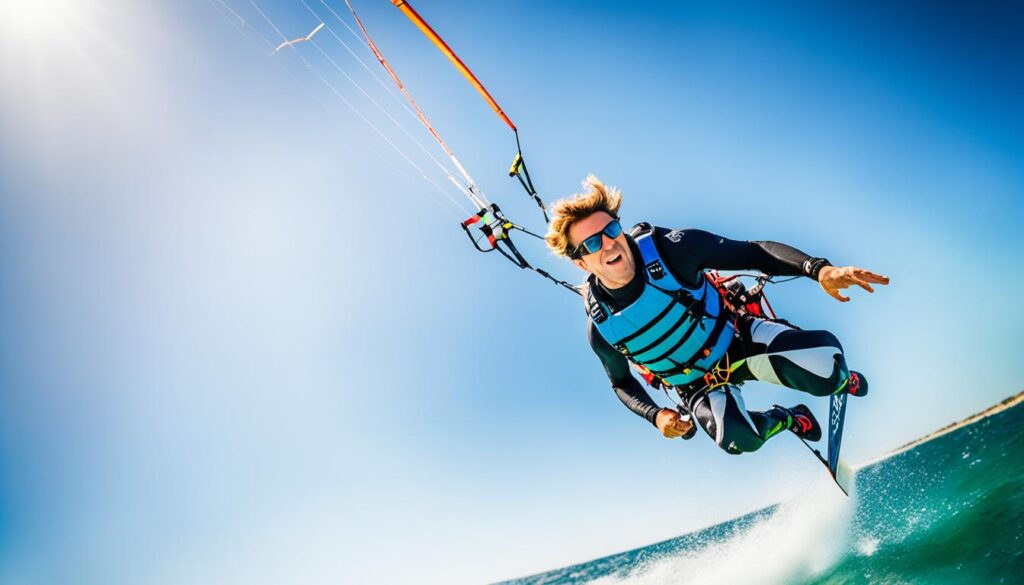Imagine feeling the wind push you across the water. This is what kitesurfing for beginners feels like. It’s a thrilling water sport that brings excitement and adventure. This guide will help you understand what to expect when you start learning kitesurfing.
This article is here to help newbies know what to look forward to in their first kitesurfing lesson. You’ll learn the basics, how to stay safe, and how to use your gear. With the right help and a strong will, kitesurfing welcomes you with open arms. Remember these beginner kitesurfing tips, and you’ll be gliding on the waves in no time.
Introduction to Kitesurfing: Embracing the Wind and Waves
Kitesurfing is a thrilling sport that mixes the excitement of water sports with nature. It started in the 1970s with simple designs and has grown into a popular sport today. Now, it’s loved all over the world.
At its core, kitesurfing is about using a kite to ride the wind on water. It’s a fun way to use the wind and the waves. It’s different from sports played on land.
Kitesurfing lets you feel free and gets you stronger. It also connects you with nature in a special way. It teaches us to respect the ocean and its creatures.
There are many ways to kitesurf, like freestyle, wave riding, and speed kitesurfing. Each style brings its own excitement. Kitesurfers meet up at places like Maui and Cape Town to share their love for the sport.
Kitesurfing is getting more popular every day. It’s a great way to enjoy the water and the wind. It’s fun, challenging, and brings people together.
Understanding the Basics of Kitesurfing Equipment
Starting with kitesurfing means picking the right gear is key. It makes you safer and helps you do better. Let’s look at what you need to know as a beginner.
The main thing is the kite. Kites for kiteboarding come in many shapes and sizes. Each one is for different winds and riding styles.
Then, there’s the kiteboard. It’s like a wakeboard or surfboard but for kiteboarding. The size and flexibility depend on your weight and how much you know, and the type of kiteboarding you do.
The harness connects you to the kite with the lines. It helps you control the kite. Make sure it fits well so the kite’s force spreads out evenly on your body.
Don’t forget the safety gear for kitesurfing. This includes a helmet, life vest, and sometimes a quick-release system. These things are key to staying safe and having fun.
Learning how to set up your kiteboarding gear is part of your first lesson. You’ll learn to put it together safely and right for the conditions and what you like.
Knowing what each piece of gear does helps you be ready for your kitesurfing adventures. The right gear helps you perform better and keeps you safe from nature’s surprises.
The Role of Weather in Your Kitesurfing Experience
Knowing about kitesurfing weather is key for a safe and fun day. For beginners, the right wind is very important. Winds between 12 to 25 knots are perfect for starting out.

Not all winds are good for kitesurfing. Offshore winds can blow you out to sea. Gusty winds can also be tough. Learning to read the weather helps you plan safely.
Weather affects your kitesurfing too. You want clear skies for better visibility. Learning to read the weather helps you know when it’s best to go kitesurfing.
As you get better, you learn how weather changes affect kitesurfing. This knowledge keeps you safe and helps others too. Kitesurfing is thrilling, but respecting nature is key.
Mastering the Art of Kite Control
Learning to control a kite is key to a fun kitesurfing experience. It’s a skill you’ll use for all your kitesurfing moves. From the start, it’s important to get good at flying a kite.
For beginners, kite control means learning and doing several things well. This includes launching and landing, changing direction, and controlling speed.

Kite control is about moving with the kite and the wind. In the first lessons, you’ll learn how to handle the kite safely. This is important for your safety and confidence.
Getting good at kite control takes time and patience. With each practice, you’ll get better at working with the wind and the kite.
At first, you might struggle with oversteering. This can cause you to lose control or crash. But don’t worry, with more practice, you’ll get the hang of it.
Instructors say every pro kite surfer was once a beginner. They know it takes time and effort to master kite control. But it’s worth it.
Progressing from Land to Water: A Transitional Phase
The journey from land-based kite training to water launch kitesurfing is exciting. It moves you from learning on solid ground to the water’s unpredictable waves. This change brings new challenges and thrills.
To start transitioning to water kitesurfing, you must master kite control on land. You need to be sure about launching, flying, and landing the kite on the beach. These skills help you control and stay safe in the water, where things like buoyancy and waves are different.
When you first get into the water, the kite pulls you along the surface. This is both exciting and challenging. Water launch kitesurfing needs good coordination and knowledge of water and wind patterns. These are different from the land where you started.
Safety is very important when you’re moving from land to water. Always wear a life jacket and know the rules of the water. Having an instructor with you is also key. They can help you solve problems and make you feel more confident in the water.
When you mix your land skills with the water, it feels great. Practice and follow safety rules to make this transition smooth and fun.
Conclusion
We’re finishing up the kitesurfing basics. We’ve looked at the exciting parts of starting kitesurfing. We talked about controlling the kite and understanding wind and waves.
Learning can be hard at first, but every challenge is part of the fun. It’s like a big adventure that leads to getting really good.
First lessons are key. They help you learn safely and teach you how to do things right. Being patient is important in kitesurfing. Slowly, you’ll get better and feel more confident.
Joining the kitesurfing world means you’re part of a group that loves the sea and adventure. We suggest you meet others who like kitesurfing too. As you keep practicing, you’ll feel free and proud with each new skill you learn.
Now, keep going and let your love for kitesurfing grow. The sky is the limit for your new hobby.
